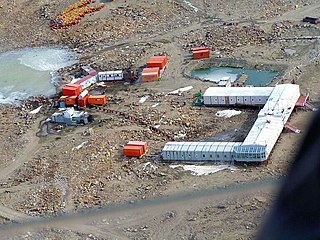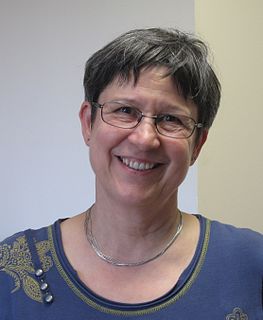Related Research Articles

The National Snow and Ice Data Center, or NSIDC, is a United States information and referral center in support of polar and cryospheric research. NSIDC archives and distributes digital and analog snow and ice data and also maintains information about snow cover, avalanches, glaciers, ice sheets, freshwater ice, sea ice, ground ice, permafrost, atmospheric ice, paleoglaciology, and ice cores.

The Byrd Polar and Climate Research Center (BPCRC) is a polar, alpine, and climate research center at The Ohio State University founded in 1960.

The Indian Antarctic Program is a multi-disciplinary, multi-institutional program under the control of the National Centre for Polar and Ocean Research, Ministry of Earth Sciences, Government of India. It was initiated in 1981 with the first Indian expedition to Antarctica. The program gained global acceptance with India's signing of the Antarctic Treaty and subsequent construction of the Dakshin Gangotri Antarctic research base in 1983, superseded by the Maitri base from 1989. The newest base commissioned in 2012 is Bharati, constructed out of 134 shipping containers. Under the program, atmospheric, biological, earth, chemical, and medical sciences are studied by India, which has carried out 30 scientific expeditions to the Antarctic as of 14 October 2010.

The United States Antarctic Program is an organization of the United States government which has presence in the continent of Antarctica. Founded in 1959, the USAP manages all U.S. scientific research and related logistics in Antarctica as well as aboard ships in the Southern Ocean.

The Scientific Committee on Antarctic Research (SCAR) is an interdisciplinary body of the International Science Council (ISC). SCAR coordinates international scientific research efforts in Antarctica, including the Southern Ocean.

Dome Fuji, also called Dome F or Valkyrie Dome, is an Antarctic base located in the eastern part of Queen Maud Land at 77°30′S37°30′E. With an altitude of 3,810 m or 12,500 ft above sea level, it is the second-highest summit or ice dome of the East Antarctic ice sheet and represents an ice divide. Dome F is the site of Dome Fuji Station, a research station operated by Japan.

Timothy Raymond Naish is a New Zealand glaciologist and climate scientist who has been a researcher and lecturer at Victoria University of Wellington and the Director of the Antarctic Research Centre, and in 2020 became a programme leader at the Antarctic Science Platform. Naish has researched and written about the possible effect of melting ice sheets in Antarctica on global sea levels due to high CO2 emissions causing warming in the Southern Ocean. He was instrumental in establishing and leading the Antarctica Drilling Project (ANDRILL), and a Lead Author on the Intergovernmental Panel on Climate Change (IPCC) 5th Assessment Report (2014).

The General Artigas Station, also referred to as the Artigas Base is the larger of the two Uruguayan scientific research stations in Antarctica, the other one being Elichiribehety Base. It is one of the 68 bases in Antarctica.
This is a list of climate change topics.
The 20th Indian Antarctic Expedition was flagged off on-board M.V. Magdalena Oldenorff from Cape Town on 30 December 2000. The team comprising a total of 51 members was led by Shri Mervin J. D’Souza from Geological Survey of India. The 20th IAE team consisted of 51 members including 34 scientists from various scientific Organizations/Universities/Departments and 17 logistic members. After successful completion of all logistics and scientific tasks the 20th IAE team returned to India in March 2002.
Ellen Mosley-Thompson is a glaciologist and climatologist. She is a Distinguished University Professor at The Ohio State University (OSU) and Director of the Byrd Polar and Climate Research Center at OSU. She is known as a pioneer in the use of ice cores from the Polar Regions for paleoclimatic research and is an influential figure in climate science. She is an elected fellow of the American Association for the Advancement of Science, the American Geophysical Union and an elected member of the National Academy of Sciences.

Research stations in Queen Maud Land are connected by the Dronning Maud Land Air Network Project (DROMLAN), which is a cooperative agreement for transportation between eleven nations with research stations in East Antarctica. Long-range aircraft fly between Cape Town, South Africa and either the Troll Airfield, located at the Troll research station, or the runway at the Novolazarevskaya Station. From these two main airfields, smaller aircraft may fly further to other Antarctic destinations.

Jemma L Wadham is a British glacial biogeochemist.
Carlota Escutia Dotti is a geologist, best known for her work on the geologic evolution of Antarctica and the global role of the Antarctic ice cap. Escutia is based at the Instituto Andaluz de Ciencias de la Tierra, Universidad de Granada and the High Council for Scientific Research (CSIC).

Nancy Bertler is an Antarctic researcher, who has led major initiatives to investigate climate history using Antarctic ice cores, and best known for her leadership of the Roosevelt Island Climate Evolution Programme (RICE). She is an associate professor at the Antarctic Research Centre at Victoria University of Wellington in New Zealand.

Catherine Ritz is a French Antarctic researcher, best known for her work on ice sheets and their impact on sea level rise.

Louise Tolle Huffman is an American teacher with over 30 years of teaching experience with many years focused on polar science and climate studies, and has written educational outreach books and articles on Antarctica. She is the Director of Education and Outreach for the US Ice Drilling Program Office (IDPO), responsible for outreach efforts highlighting IDPO scientists and their research results.

Julie Michelle Palais is an award-winning polar glaciologist who has made significant contributions to climate change research studying volcanic fallout in ice cores from both Greenland and Antarctica. For many years, starting in 1990, she played a pivotal role working at the National Science Foundation (NSF) as Program Director of the Antarctic Glaciology Program in the Division of Polar Programs, including many trips to both North and South Polar regions. Both the Palais Glacier and Palais Bluff in Antarctica were named in her honor and she has received many further recognitions for her distinguished career.

Ian Frederick Allison AO AAM FAA is an internationally recognised Australian glaciologist and climate scientist. He was elected a Fellow of the Australian Academy of Science in 2016 in recognition of his work in understanding the role of "sea ice and Antarctica in the global climate system".

Amelia E. Shevenell is an American marine geologist who specializes in high-latitude paleoclimatology and paleoceanography. She is currently an Associate Professor in the College of Marine Science at the University of South Florida. She has made notable contributions to understanding the history of the Antarctic ice sheets and published in high-impact journals and, as a result, was awarded full membership of Sigma Xi. She has a long record of participation in international ocean drilling programs and has served in leadership positions of these organizations. Shevenell is the elected Geological Oceanography Council Member for The Oceanography Society (2019-2021).
References
International Trans-Antarctic Science Expedition. 1977–1997. University of Maine. 10 Nov. 2007
West, Peter. “International Trans-Antarctic Science Expedition (ITASE).” National Science Foundation News. 10 Feb. 2003. 13 Nov. 2007